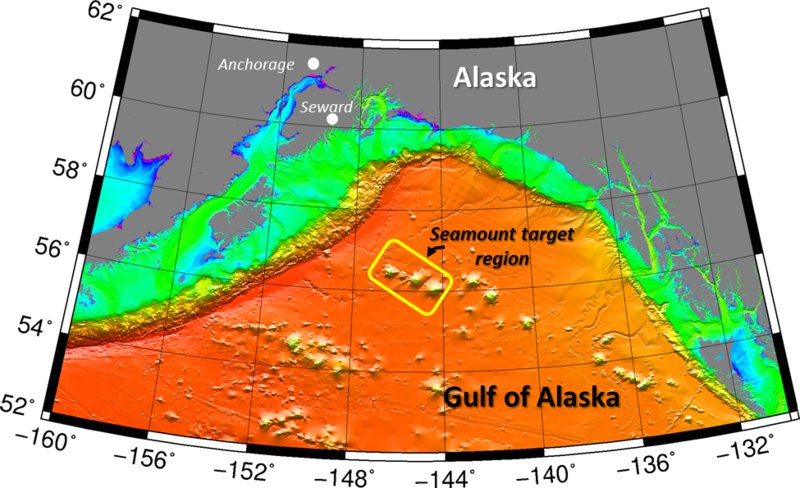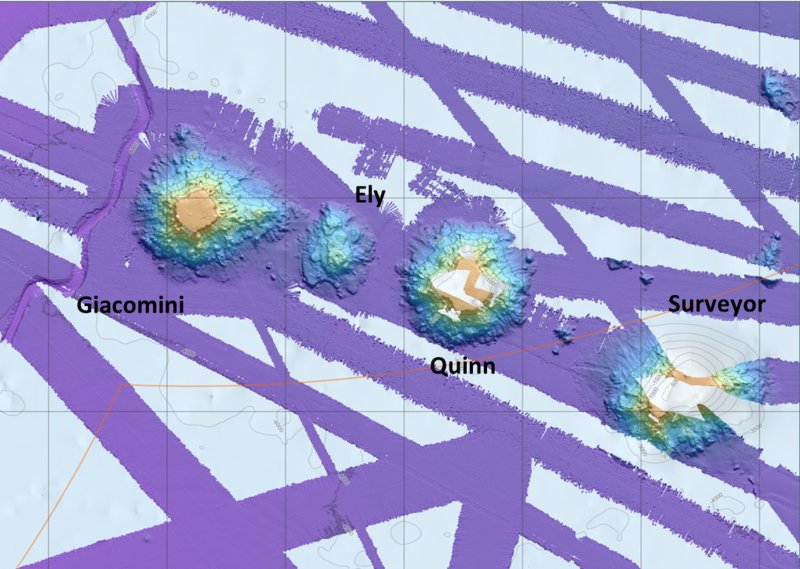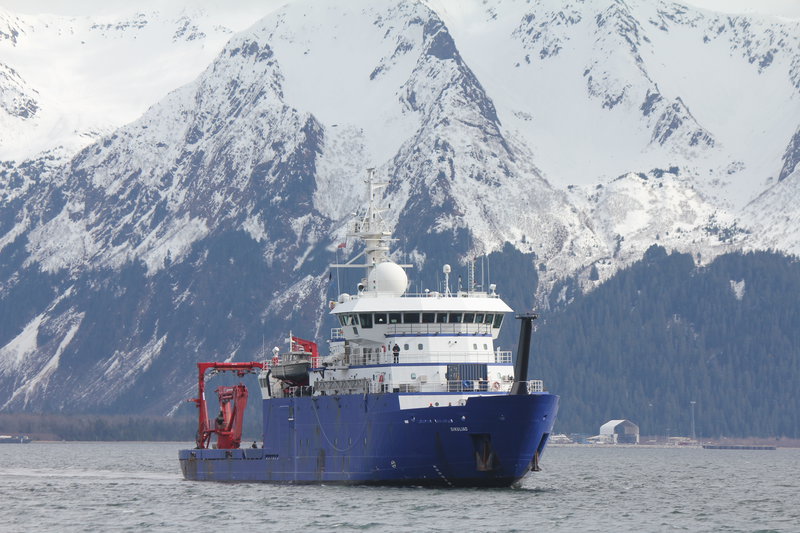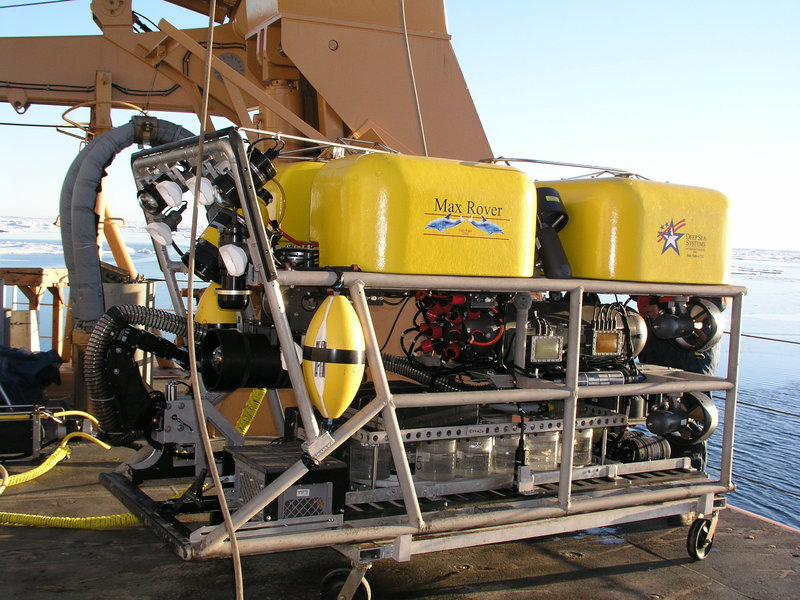
By Katrin Iken, Professor in Marine Biology, College of Fisheries and Ocean Sciences - University of Alaska Fairbanks
and Russ Hopcroft, Professor in Oceanography, College of Fisheries and Ocean Sciences - University of Alaska Fairbanks
The Gulf of Alaska is part of the northern-most portion of the North Pacific and is a productive system well known for its iconic species and extensive fisheries that supply U.S. and international markets with high-quality seafood. The continental shelf system of the Gulf of Alaska is relatively well known, yet much less is understood about the deep portion of the Gulf. The Gulf of Alaska deep-sea region is hydrographically and topographically complex with numerous channels, deepwater canyons, and seamount chains. The Gulf’s ecological health has been compromised by recent anomalous warming in the North Pacific since 2014 and has already shown ecosystem-wide responses from phytoplankton, the small microalgae supporting the base of the food web, to the largest whales.

Bathymetric map of the Gulf of Alaska, showing its deep basin with seamount chains. Grey – land, Green – continental shelf, Yellow – continental slope, Orange – deep basin. Image courtesy of Dr. Seth Danielson, UAF. Download larger version (jpg, 567 KB).
One of the special topographic features of the Gulf of Alaska basin are the about 35 seamounts of volcanic origin. Most of the seamounts rise between 1,000 to 3,500 meters (3,280 to 11,480 feet) above the basin seafloor, but with their summits remaining relatively deep, typically reaching only within 650 meters (2,130 feet) of surface waters. Globally, more than half of all seamounts are located in the Pacific Ocean. Seamounts in general interact with the surrounding deep-sea system through alteration of the deep water column structure with effects on mixing and nutrient concentrations as well as the exchange of biota. Ecological, evolutionary, and hydrographic processes on seamounts differ from surrounding deep-sea habitats, in part due to their topographically complex habitat structure. These conditions can contribute to high biodiversity regions – from microbes to fish – within the otherwise more species-poor deep-sea pelagic and seafloor ecosystems.

Side-scan sonar bathymetry of the Giacomini and Quinn seamounts in the Gulf of Alaska, which are target seamounts in this mission. Data compiled by Steve Roberts, Seward Marine Center UAF, http://realtime.sikuliaq.alaska.edu/realtime/map/skq.html Download larger version (jpg, 617 KB).
From July 21 – August 3, 2019, a multi-disciplinary and international team of scientists and media personnel will sail from Seward, Alaska, to the Gulf of Alaska Seamounts region onboard R/V Sikuliaq. This mission, funded by the NOAA Office of Ocean Exploration, will employ an ecosystem perspective to investigate microbial communities in seawater and seafloor environments surrounding the seamounts; water column (planktonic) organisms; and invertebrate and fish benthic (seafloor) communities on and off the seamounts. The will also conduct observations of seabirds and marine mammals. This work will help us better understand the diversity of marine life in this underexplored region of economic importance that is also poised to undergo unprecedented change.

R/V Sikuliaq, a world-class oceanographic research vessel owned by the National Science Foundation and operated by the College of Fisheries and Ocean Sciences at the University of Alaska Fairbanks, returns to its home port in Seward, Alaska, to pick up a new science crew. Image courtesy of Sarah Spanos. Download larger version (jpg, 8.2 MB).
This mission will be using the research vessel (R/V) Sikuliaq. Commissioned in 2015, the 261-foot Sikuliaq is owned by the National Science Foundation and operated by the College of Fisheries and Ocean Sciences at the University of Alaska Fairbanks (UAF). She is as part of the University-National Oceanographic Laboratory System (UNOLS) research fleet and is one of the most advanced university research vessels in the world. Sikuliaq’s home port is in Seward, Alaska, at UAF's Seward Marine Center.
The central technology during this mission is the remotely operated vehicle (ROV) Global Explorer, operated by Oceaneering International. The ROV is depth rated to 3,000 meters (9,840 feet) and is equipped with multiple 4K and 3D high-definition cameras to take unprecedented video and still images of the fragile gelatinous plankton in the water column surrounding the seamounts and the seamount seafloor. The vehicle also has a variety of sampling equipment specialized for the target organisms of this mission. Suction samplers can pull organisms into one of 12 sampling containers on a rotating carousel; these so-called Detritus-samplers can gently enclose fragile jellyfish into a sampler without ever touching them. Also, a biobox is available to hold larger, non-mobile seafloor organisms. The ROV is operated from a command van on the back deck of the Sikuliaq, where ROV pilots carefully maneuver the vehicles and operate the sampling arms in close collaboration with the scientists.
ROV sampling will be complemented by several more traditional oceanographic sampling tools such as a variety of nets to capture the more robust zooplankton organisms, a CTD (Conductivity-Temperature- Depth) that measures hydrographic profiles through the water column and collects water from discrete water depths through its attached array or Niskin bottles, a box corer that is able to stencil out a square sample of seafloor mud and bring it to the surface, and a small bottom trawl that collects fishes and larger seafloor invertebrates away from the seamounts.

ROV Global Explorer by Oceaneering has a multitude of imaging and sampling capabilities ideal for deepwater exploration. Image courtesy of Katrin Iken. Download larger version (jpg, 2.4 MB).
This project is funded by the NOAA Office of Ocean Exploration and Research with additional ship support by the National Science Foundation and the University of Alaska Fairbanks. Science partners during this mission include scientists from the University of Alaska Fairbanks, the University of Manitoba Canada, the Japan Agency for Marine-Earth Science and Technology (JAMSTEC), the University of Hawaii, University of Barcelona Spain, Lamont Doherty Earth Observatory at Columbia University, the U.S. Fish and Wildlife Service, and a Microcosm film team from Montrose Pictures. Our partner for the ROV is Oceaneering.